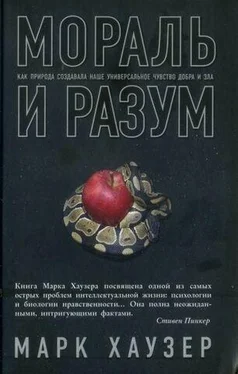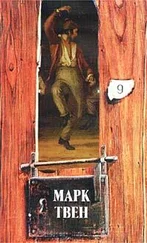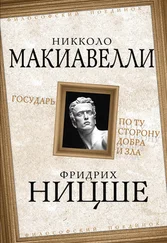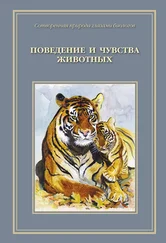Hassani О. К & Cromwell H. C. (2001). Influence of expectation of different rewards on behavior-related neuronal activity in the striatum // Journal of Neurophysiology, 85, 2477—2489.
Hasselmo M. R., Rolls E. T & Baylis G. C. (1989). The role of expression and identity in the face-selective responses of neurons in the temporal visual cortex of the monkey // Behavioural Brain Research, 32, 203—218.
Hauser M. D. (1992). Costs of deception: cheaters are punished in rhesus monkeys // Proceedings of the National Academy of Sciences, 89, 12137—12139.
Hauser M. D. (1993). Rhesus monkey (Macaca mulatto} copulation calls: Honest signals for female choice? // Proceedings of the Royal Society, London, 254, 93— 96.
Hauser M. D. (1996). The Evolution of Communication. Cambridge, MA: MIT Press.
Hauser M. D. (1997). Minding the behavior of deception // A. Whiten & R. W Byrne (Eds.), Machiavellian Intelligence II (p. 112—143). Cambridge: Cambridge University Press.
Hauser М. D. (1998). Expectations about object motion and destination: Experiments with a nonhuman primate // Developmental Science, 1, 31—38.
Hauser M. D. (2000). Wild Minds: What Animals Really Think. New York: Henry Holt.
Hauser M. D. & Carey S. (1998). Building a cognitive creature from a set of primitives: Evolutionary and developmental insights // D. Cummins & C. Alien (Eds.), The Evolution of Mind (p. 51—106). Oxford: Oxford University Press.
Hauser M. D ., Chen M. K., Chen E. & Chuang E. (2003). Give unto others: genetically unrelated cotton-top tamarin monkeys preferentially give food to those who altruistically give food back // Proceedings of the Royal Society, London, B, 270, 2363—2370.
Hauser M. D., Chomsky N. & Fitch W. T (2002). The faculty of language: What is it, who has it, and how did it evolve? // Science, 298 , 1569—1579.
Hauser M. D. & Spelke E. (2004). Evolutionary and developmental foundations of human knowledge // M. Gazzaniga (Ed.), The Cognitive Neurosciences (p. 853—865). Cambridge, MA: MIT Press.
Hawkes K. (2003). Grandmothers and the evolution of human longevity // American Journal of Human Biology, 15, 380—400.
Hazlitt W. (1805/1969). An Essay on the Principles of Human Action and Some Remarks on the Systems of Hartley and Helvetius. Gainesville, FL: Scholars’ Facsimiles and Reprints.
Heider E & Simmel M. (1944). An experimental study of apparent behavior // American Journal of Psychology, 57, 243—259.
Heinsohn R. & Packer C. (1995). Complex cooperative strategies in group-territorial African lions // Science, 269, 1260—1262.
Henrich J., Boyd R., Bowles S., Camerer C, Fehr E., Gintis H. & McElreath R. (2001). In search of Homo economicus: behavioral experiments in fifteen smallscale societies // American Economics Review, 91, 73—78.
Henrich ]., Boyd R., Bowles S., Camerer G, Fehr E., G intis H., McElreath R., Barr A., EnsmingerJ., Hill K., Gil-White F, Gurven M., Marlowe E, Patton J. Q., Smith N. & Tracer D. (in press). Economic Man in cross-cultural perspective: behavioral experiments in 15 small scale societies // Behavioral and Brain Research, 28, 795—855.
Heyes С. M. (1998). Theory of mind in nonhuman primates // Behavioral and Brain Sciences, 21, 101—114.
Higley J. D.,Mehlman P T, Higley S. B.,Femald B., Vickers J., Lindell S. G., Taub D. M., Suomi S. J. & Linnoila M. (1996). Excessive mortality in young free-ranging male nonhuman primates with low cerebrospinal fluid 5-hydroxy-indoleacetic acid concentrations // Archives of General Psychiatry, 53, 537—543.
Hill K. (2002). Altruistic cooperation during foraging by the Ache, and the evolved human predisposition to cooperate // Human Nature, 13, 105—128.
Hinde R. A. (2003). Why Good Is Good: The sources of morality. London: Routledge.
Hirschfeld L. A. (1996). Race in the Making: Cognition, culture and the child’s construction of human Kinds. Cambridge, MA: MIT Press.
Hirschi T & Gottfredson M. R. (1983). Age and the explanation of crime // American Journal of Sociology, 89, 552—584.
Hobbes T (1651/1968). Leviathan. New York: Penguin.
Hobbes Т (Ed.). (1642/1962). De Corpore. New York: Oxford University Press.
Hobson R. R (2002). The Cradle of Thought. London: Macmillan.
Hoffman M. L. (2000). Empathy and Moral Development. Cambridge: Cambridge University Press.
Hollander E. & Stein D. (1995). Impulsivity and Aggression. New York: Wiley Press.
Horder J. (1992). Provocation and Responsibility. Oxford: Clarendon Press.
Hrdy S. B. (1999). Mother Nature: A history of mothers, infants, and natural selection. New York: Pantheon Books.
Hume D. (1739/1978). A Treatise of Human Nature. Oxford: Oxford University Press.
Hume D. (Ed.). (1748). Enquiry Concerning the Principles of Morals. Oxford: Oxford University Press.
Huntsman R. W. (1984). Children’s concepts of fair sharing //Journal of Moral Education, 13, 31—39.
Hurley S. (2003). Animal action in the space or reasons // Mind and Language, 18, 231—256.
Hursthouse R. (1999). On Virtue Ethics. New York: Oxford University Press.
Hutcheson F (1728/1971). Illustrations on the Moral Sense. Cambridge, MA: Harvard University Press.
Huxley T H. (1888). The struggle for existence: a programme // Nineteenth Century, 2 J, 161—180.
Inagaki K. & Hatano G. (2002). Young Children’s Thinking about the Biological World. New York: Psychology Press.
Inagaki K. & Hatano G. (2004). Vitalistic causality in young children’s naive biology // Trends in Cognitive Science, #[#], 356—362.
Intrator J., Hare R. D., Stritzke R, Brichtswein K., Dorfman D., Harpur T, Bernstein D., Handelsman L., Schaefer C., Keilp ]., Rosen J. & Machac J. (1997). A brain imaging (single photon emission computerized tomography) study of semantic and affective processing in psychopaths // Biological Psychiatry, 42, 96—103.
Ivins M. (2004). Imperialists’ ball. The Progressive, June, 50.
JackendojfR. (2002). Foundations of Language. New York: Oxford University Press.
Jefferson T. (1787/1955). Letter to Peter Carr, August 10 //J. P Boyd (Ed.), The Papers of Thomas Jefferson (p. 15).
Johnson S. C. (2000). The recognition of mentalistic agents in infancy // Trends in Cognitive Science, 4, 22—28.
Johnson S. C. (2003). Detecting agents // Philosophical Transactions of the Royal Society of London, B, 358, 549—559.
Johnson S. C. & Carey S. (1998). Knowledge enrichment and conceptual change in folk biology: evidence from people with Williams syndrome // Cognitive Psychology, 37, 156—200.
Johnstone R. A. & Dugatkin L. A. (2000). Coalition formation in animals and the nature of winner and loser effects // Proceedings of the Royal Society, London, B, 267, 17—21.
KacelnikA. (1997). Normative and descriptive models of decision making, time discounting and risk sensitivity // G. Bock & G. Cardew (Eds.), Characterizing Human Psychological Adaptations (p. 51—70). London: Wiley.
Kacelnik A. (2003). The evolution of patience // G. Loewenstein (Ed.), Time and Decision: Economics and Psychological Perspectives on Intertemporal Choice (p. 115—138). New York: Russell Sage Foundation.
Читать дальше











